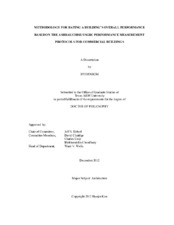| dc.description.abstract | This study developed and applied a field test to evaluate the American Society of Heating, Refrigerating and Air-Conditioning Engineers (ASHRAE)/Chartered Institute of Building Services Engineers (CIBSE)/United States Green Building Council (USGBC) Performance Measurement Protocols (PMP) for Commercial Buildings in a case-study office building in central Texas. As the first integrated protocol on building performance measurement, the ASHRAE PMP accomplished its goal of providing the standardized protocols for measuring and comparing the overall performance of a building, including energy, water, thermal comfort, Indoor Air Quality (IAQ), lighting, and acoustics. However, several areas for improvement were identified such as conflicting results from different procedures or benchmarks provided in the ASHRAE PMP; limited guidelines for performing the measurements; lack of detailed modeling techniques, graphical indices, and clear benchmarks; and some practical issues (i.e., high cost requirements and time-intensive procedures). All these observations are listed as the forty issues, including thirteen for energy, five for water, and twenty-two for Indoor Environmental Quality (IEQ).
Recommendations were developed for each issue identified. For the selected high-priority issues, twelve new or modified approaches were proposed and then evaluated against the existing procedures in the ASHRAE PMP. Of these twelve new or modified approaches, the following are the most significant developments: a more accurate monthly energy use regression model including occupancy; a monthly water use regression model for a weather-normalized comparison of measured water performance; a method how to use a vertical temperature profile to evaluate room air circulation; a method how to use LCeq – LAeq difference as a low-cost alternative to estimate low frequency noise annoyance; a statistical decomposition method of time-varying distribution of indices; and a real-time wireless IEQ monitoring system for the continuous IEQ measurements.
The application of the forty recommendations and the twelve new or modified approaches developed in this study to the ASHRAE PMP is expected to improve the applicability of the ASHRAE PMP, which aligns the overall purpose of this study. Finally, this study developed a new single figure-of-merit rating system based on the ASHRAE PMP procedures. The developed rating system is expected to improve the usability of the protocols. | en |


